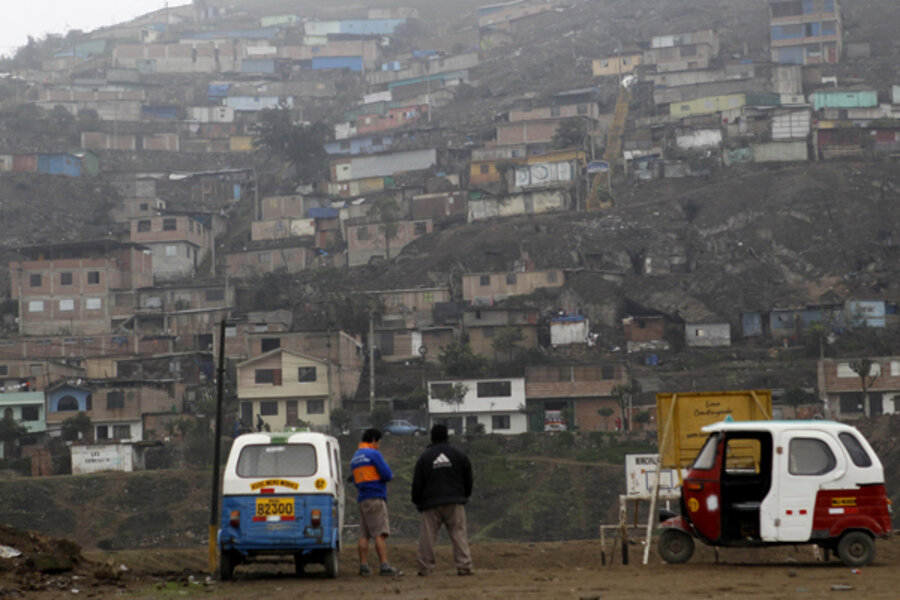Easy credit, big debt: Peru tackles financial ed for its growing middle class
Loading...
| Lima, Peru
Enrique Diaz remembers the moment he understood how badly Peru needed a financial literacy movement: In line at a KFC restaurant, a customer handed over her credit card and the cashier asked if she would like to pay in four installments. The customer said yes, unwittingly committing to pay interest on a fast food meal for her family.
“The [economic] bonanza has come to Peru,” says Mr. Diaz, president of MC&F, whose Proyecto Alcanzar, Project Reach, partners with corporations to teach personal finance to their workers. “But people don’t know how to manage their money. They go into debt with credit cards, and they don’t know how to save.”
Peru's economy has expanded over 10 years of sustained growth, and analysts expect 6 percent GDP growth again this year. This has stoked Peruvians’ desire for the kinds of goods and services coveted by the middle class worldwide – TVs, cars, homes, and name brand clothes – and provided the higher earnings and access to credit to get them. But an unintended consequence, seen echoed across much of Latin America's emerging middle class, is the increased risk of falling into debt.
This has prompted greater oversight by the government and a push for financial education both in Peru and other Latin American nations, a signal of how central banks and financial regulators in the region have become more independent and conservative since the boom-bust cycles of the 1980s and 1990s. Analysts say Peru's central bank rightfully pulled back the reins on lenders earlier this year to avoid a bubble in consumer credit. Still, personal debt remains an issue.
“I think that responsibly managed credit is good because it gives you access to new possibilities,” Pedro Villegas, a Lima-based analyst with PwC says.
“But the problem is that people are using credit to buy basic provisions. The greatest risk is when it generates a carousel effect … [where] people go into debt with one card, so they acquire another and so on. They are destined to go bankrupt.”
Credit's role in growing economy
Consumer loans, not including mortgages, climbed 23 percent to $10.34 billion in 2012 compared with the prior year, according to the Association of Banks of Peru, or ASBANC. Home loans increased 30 percent over the same period, to $9.26 billion.
Traditional credit card issuers Visa and Mastercard are seeing revenue from Latin America grow at double-digit levels. In Peru, department stores and mass merchandisers issue branded cards that let people defer payments on everything from electronics and toys to clothes and food. That’s where people begin to run risks, says Mr. Villegas.
Credit plays an important role in a growing economy, allowing people to pay for large purchases over time that would otherwise be beyond their reach such as a home, car, or computer, Villegas says.
A wave of financial literacy efforts began five years ago when the government bank regulator initiated an education campaign and has since grown. While Peru’s bank regulator, known as the SBS, operates a web portal and has begun providing occasional courses in secondary schools, Diaz says the effort falls far short of the need. Companies like Diaz’s MC&F and projects such as the Inter-American Development Bank’s ProSavings have tried to fill the gap in information to consumers, from the poor to the middle class.
“One of the principal shifts has been how entities like central banks have begun to recognize the importance of keeping an eye on the consequences of weak financial education and regulation of credit,” says Fermin Vivanco, senior specialist with the IDB’s Multilateral Investment Fund, whose ProSavings project works to develop savings instruments and teach financial education in Peru, Colombia, Dominican Republic and El Salvador.
Last year, neighboring Ecuador restricted mass merchandisers from issuing credit cards, a measure to slow their growth. But Diaz says countries should bet instead on improving financial education. He believes the country needs a national financial literacy policy like the one recently created in the US, where the Consumer Financial Protection Bureau issued its first financial literacy report to Congress in July.
Peru's 'unbanked'
From the 21st floor of a tower in the San Isidro neighborhood, Inteligo analyst Roberto Flores can watch the headlights of Lima’s rush hour stream by below. Every year, tens of thousands of vehicles join the capital’s fleet, a consequence of the increased access to auto loans.
Despite fast-growing credit, there are still many Peruvians who aren't even a part of the formal financial system. Mr. Flores says the country substantially lags behind its peers in Latin America in terms of reaching the "unbanked." Only 27 percent of Peru’s population uses a bank, compared with a “banked” population of 40 percent in Mexico, nearly 60 percent in Brazil, and 75 percent in Chile, he says.
ProSavings is working to develop savings instruments for Peru’s poor unbanked, many of whom can’t yet access credit but receive a monthly subsidy from the government. The project also focuses on teaching recipients how to save for specific goals.
Diaz teaches workshops to employees in the formal sector, including in Peru’s crucial mining industry. Miners often have the benefit of a spring bonus, when profit-sharing payments can double or triple their monthly salary – and yet miners quickly run out of money or go into debt, he says.
“As the financial system becomes more complex, it’s easy to become confused,” Diaz says. But with increasing education, “the coming generations are going to be more and more informed.”








